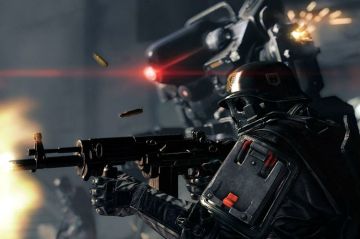When I first heard about Wolfenstein: The New Order, the concept unsettled me.
The game imagines an alternate history, in which the Nazis won World War II. Democracy has fallen, and the Nazis rule with an army of mechanized super-soldiers. Once again, William “B.J.” Blazkowicz has to kill a whole bunch of Nazis.
I’m used to video games that use Nazis as villains, turning them into fodder for our amusement. Wolfenstein 3D hooked me on PC gaming 20 years ago. I totally get the catharsis that comes with killing virtual Nazis, and have indulged in my fair share.
But as someone with two grandparents who survived the Holocaust, something about this reinvention of the series didn’t sit right with me. These Nazis are being portrayed as badass robots, rather than horrifying humans. Although Wolfenstein has dabbled in sci-fi and supernatural themes since the beginning, New Order appears to go even further by making robots and mechs the main attraction. After seeing the first trailers for the game, I wondered whether the new Wolfenstein would go too far in painting the Nazis as generic villains, ignoring why they’re so reviled in the first place.
At E3, I was able to get some answers from Andreas Ojerfors, the senior gameplay designer for Wolfenstein: The New Order. There’s only so much I can infer from the short interview, especially because publisher Bethesda Softworks is still withholding key plot details. But Ojerfors assured me that the developers at MachineGames want to treat the topic with sensitivity.
“The way we see it is, we make our game like Inglourious Basterds,” Ojerfors said. “So we have the more twisted, slightly humorous aspect of it, but we take the main theme … we take that seriously, and we look at it as something we explore together with the player.”

Tarantino’s film also indulges in an alternate history, and blends humor with catharsis. But it also makes sure to convey the actual horror of the time, most notably in the film’s opening scene. I asked Ojerfors whether Wolfenstein: The New Order does anything similar.
“Absolutely, we do,” he said. “I don’t want to tell examples of what those various scenes are, but you’ll very much experience the horror and the evil of the Nazi regime, so we do explore that.”
Ojerfors explained that Blazkowicz becomes part of a resistance movement, which includes Jews and people of many nationalities–including Germans. Over the course of the game, players will learn how these characters escaped the Nazis and joined the resistance.
“We do have the lighter, funnier elements, but we take the theme of the alternate history very, very seriously,” he said.
It’s too early to judge Wolfenstein: The New Order until we actually see what Ojerfors is talking about. I don’t expect or demand that Wolfenstein become a history lesson–this is a piece of entertainment, after all–but in creating an alternate history, it shouldn’t ignore actual atrocities that the Nazis committed. Inglourious Basterds walked that line extremely well.
For what it’s worth, the game itself is a blast. While it looks like a Call of Duty-style shooter on the surface, it’s more over-the-top when you’re actually playing it. There’s so much ammo and health scattered around that Wolfenstein seems to encourage a guns-blazing approach to combat, especially when Blazkowicz is holding an assault rifle in each hand. I already have fond memories of sprinting down a narrow hallway, shotgunning mechanized Nazis without even breaking stride. The catharsis is there; hopefully the story doesn’t let it go to waste.

